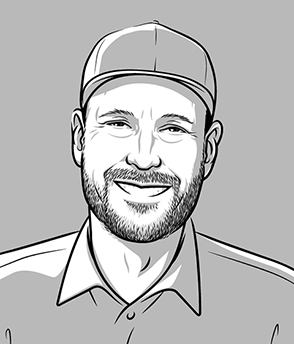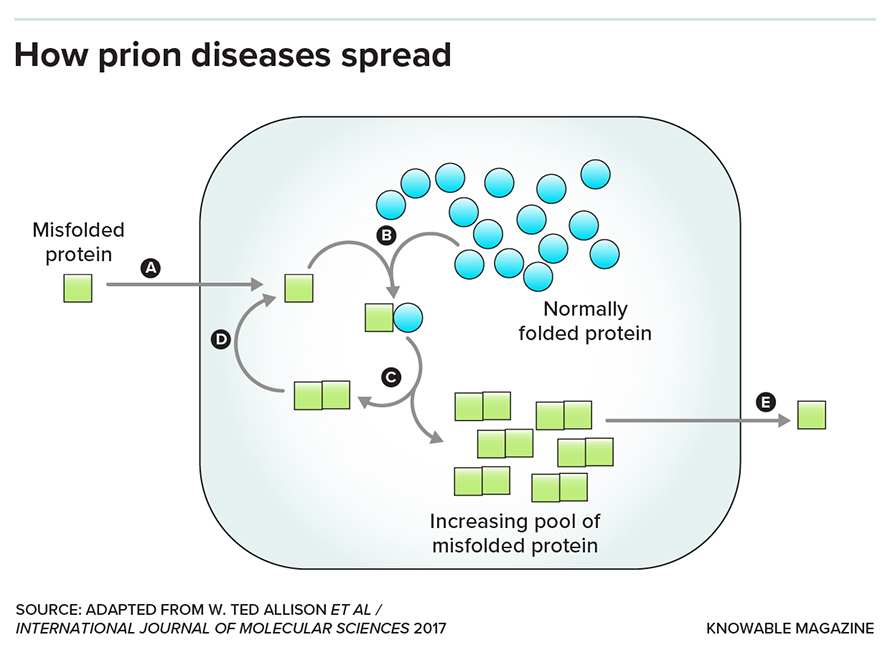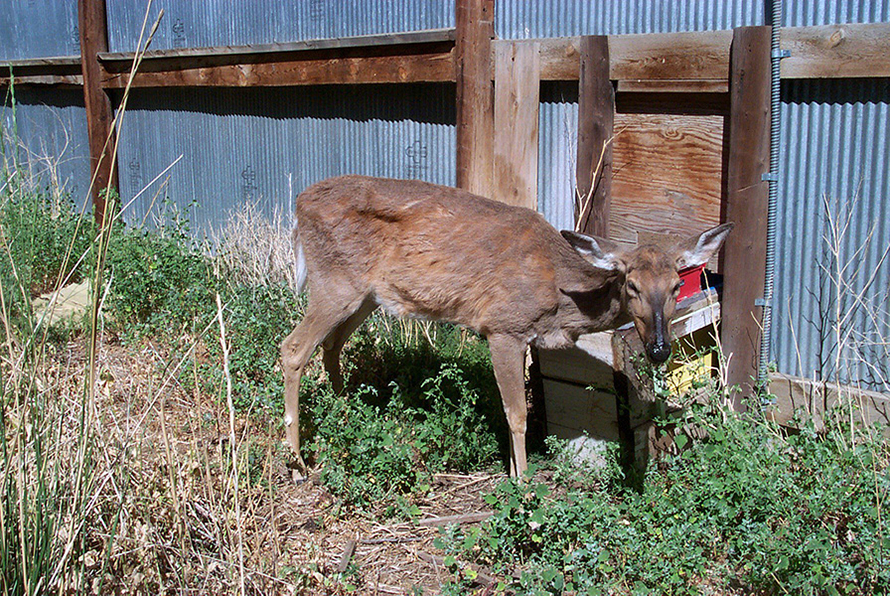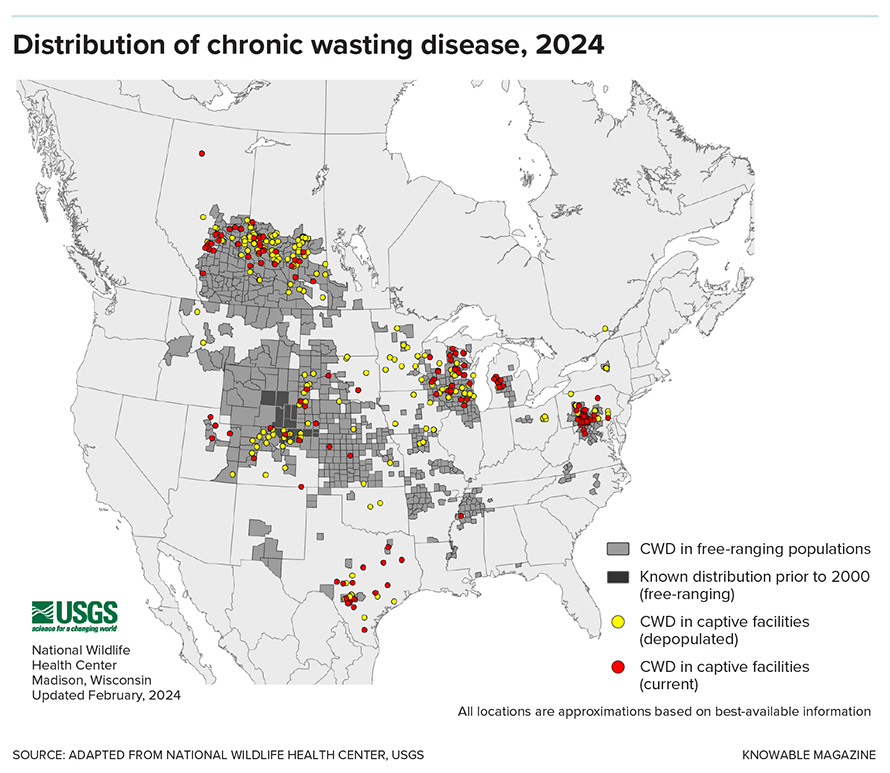How to control chronic wasting disease
A lethal, incurable malady similar to mad cow disease is sweeping across deer species in North America and starting to spread around the world. First identified in a single herd of captive mule deer in Colorado in 1967, chronic wasting disease — CWD — has now been found in captive and wild mule deer, white-tailed deer, elk, moose and reindeer. It’s been found in 32 states and has crossed international boundaries into Canada, South Korea and Norway, among other countries.

The disease — caused by a rogue protein known as a prion — has not yet been shown to infect humans, though fears remain. But even if that never happens, CWD could kill off large numbers of deer and possibly wipe out individual populations. Wildlife management agencies may, in turn, introduce stricter hunting rules, and the fear of contaminated meat could scare away potential hunters, affecting the United States’ roughly $23 billion deer hunting industry.
Since CWD’s emergence, scientists have been working to understand the disease and how it might be brought under control. Over the years, three potential mitigation strategies have emerged, but each has significant challenges. Nicholas Haley, a veterinary microbiologist at Midwestern University in Arizona, coauthored an overview of chronic wasting disease in the 2015 Annual Review of Animal Biosciences and has been working on the problem ever since. Knowable Magazine spoke with Haley about the options and whether we can ever contain the disease.
This conversation has been edited for length and clarity.
What’s a prion disease?
CWD isn’t caused by a bacterium or virus, but by a naturally occurring protein in our cells twisting out of shape.
The Kurt Vonnegut novel Cat’s Cradle describes the discovery of a new form of ice, ice-nine, which is solid even at room temperature. In the book, when ice-nine touches water, it forces all the other water to crystalize in the same way, until all the water on Earth is frozen. That’s kind of what’s happening in the body. An animal gets exposed to the prion, usually through ingesting it, and anywhere in the body that the prion encounters the normal version of itself, the abnormal protein convinces the normal protein to take this misfolded shape.
This is particularly dangerous in the central nervous system, because these proteins can build up into plaques that kill the cell. Eventually, enough cells die that you get nervous system disorders. The animal begins to behave oddly and eventually dies.
In the meantime, the sick animal can spread the prions to other animals through things like its saliva, urine or feces. The prions are very hardy and can stick around on plants or in the soil until another animal comes along and eats them.

Could we just kill all the sick animals before they can spread the disease further?
Unfortunately, that only really works if it’s done early enough. It’s like a wildfire — the sooner you can put it out, the more chance you have of keeping it from spreading. But if you let CWD fester for any length of time, then culling probably won’t work.
New York State, for example, did a huge culling operation in Oneida County back in 2005 after they identified five or six CWD-positive deer for the first time. That seems to have worked, and the state still tests animals for the disease to try to catch those outbreaks early.
But when wildlife managers tried localized culling in Colorado, it didn’t seem to affect CWD over the long term, possibly because the infectious protein had been in the area for so long that it essentially became baked into the landscape. The protein is incredibly stable and can exist in the soil for years. Or new, sick deer may have moved into the now vacant area from nearby populations. Deer aren’t symptomatic until the later stages of the disease, but they’re likely shedding the prion into the environment some time before then.
So if culling is really effective only early on, are there other strategies that can help in places where CWD is already “baked in”?
My work is largely focused on breeding CWD-resistant animals — not curing the disease, but trying to find animals that don’t get sick as easily. We’re working with a deer farm used for hunting. They have a few properties, representing about 600 to 800 deer, where CWD has become common. We first identified CWD there in 2014, and within a few years a deer on one of those properties had about a 60 to 70 percent chance to be positive for CWD.
We also did genetic testing on the animals. We found that something like 80 to 90 percent of the deer had one particular genetic variant, or allele, of the prion protein that seems incredibly susceptible to infection. But that’s only one allele out of about five possible ones in deer. And it seems like some alleles are more resistant to CWD than others.

Why?
It’s like a lock and key. The infectious CWD prion is a very good key for that one really common lock, but with different alleles, the lock is subtly different, and the key doesn’t work as well. We’re still learning exactly how it all interacts, though.
Over time, we started to focus on two different “good” alleles. I think our end goal is to use artificial insemination and other breeding practices until we have a population of animals with just the good alleles, eliminating the one we know is terrible.
Would having only animals with good alleles stop the spread?
It could make it manageable. The animals with those good gene variants are significantly less likely to get CWD, but they’re likely not completely immune. We’ve been putting more of the animals with good variants out into the farm and can see that fewer of them seem to be getting infected by the time they’re hunted — on one property where we’ve introduced a lot of selectively bred deer, we haven’t found a positive case in the past two, if not three, years.
So selective breeding might work like the Covid vaccine: It’s still possible to get a breakthrough infection, but it’s had a huge impact on slowing the disease down and minimizing transmission. And at that point, there may be management tools we could use to keep it at essentially zero. If it takes these highly resistant animals five years to get sick, but they’re all being hunted by the age of three, then eventually we won’t have any CWD, for example.

Could selective breeding work for wild animals as well, not just captive ones?
That’s a really good question. This kind of selection is happening naturally in wildlife — natural selection will favor resistant animals over time — but it’s much slower. I could see the release of captive-raised animals happening in controlled situations, such as where CWD has completely wiped out a local population. But just putting one or two bucks out onto the landscape — their genes would get diluted pretty quick.
And while there are precedents for breeding animals on a farm and releasing them into the wild, a lot of wildlife professionals are heavily against that. They want to keep wild populations wild. To introduce farm deer would taint it, in a way. And it’s something you can’t walk back. I understand that perspective. A lot of wild animal folks are putting more hope into vaccine research instead.
I know we have vaccines against viruses, but is it possible to make a vaccine against a protein?
We already do. The Covid vaccine is specifically against the spike protein of the Covid-19 virus, for example, not the virus as a whole. And prions are just other proteins. So a vaccine could theoretically work, creating antibodies that can bind to the prion protein, helping the body recognize and eliminate it.
But the problem with chronic wasting disease is that, unlike Covid, a healthy version of the problem protein already exists naturally inside our bodies. Trying to develop a vaccine that can target the unhealthy version of the protein while not attacking your healthy cells, that’s the challenge.
The way the disease works in the body might also make creating a vaccine harder. Researchers in Wyoming did some vaccine trials and found that when elk were injected with a particular experimental vaccine, they got sick faster.
What we think might have happened was this: White blood cells will naturally kill invaders and take the remains back to lymph nodes to teach the body what they saw, and activate defenses. Getting a vaccine can speed up this process by making the white blood cells better at detecting and picking up invaders.
But the problem is, in this case, that the white blood cells couldn’t destroy the prion after they picked it up. It was still infectious. So all they did was more quickly bring the prion to somewhere where it could spread, like ants bringing poison back to the nest and spreading it to others.
That isn’t to say it’d be impossible for vaccines to work, and there are groups working on the problem. I want to be optimistic. I just have reservations about it.
Also, even if we get an effective vaccine, we’d also need to figure out a good way to distribute it. It’d be impractical to use an injection on wild animals. There is a baited rabies vaccine that’s been used in the eastern United States that can be dropped out of a plane. Hypothetically, something like that could work for CWD. But there’s a lot of things that we’d have to overcome.
So overall, what do you see as the outlook in terms of managing and containing CWD?
It depends a lot on how people react. Unfortunately, states’ responses have been varied. Some take it very seriously, but some states try to sweep things under the rug. I’m expecting that, within our lifetime, it’ll be in every state in the United States except for Hawaii.
And then what? Do you think this will eventually go away? Or are we just going to have to live with it?
I think it’ll be like Covid. It won’t ever go away. It may not be as big of a deal in 100 years, but it’ll still be there.
And fingers crossed it never jumps into humans?
Yeah, well, cross your fingers harder.
This article is republished from Knowable Magazine. Read the original here.
Enjoy reading ASBMB Today?
Become a member to receive the print edition four times a year and the digital edition monthly.
Learn moreGet the latest from ASBMB Today
Enter your email address, and we’ll send you a weekly email with recent articles, interviews and more.
Latest in Science
Science highlights or most popular articles

Building the blueprint to block HIV
Wesley Sundquist will present his work on the HIV capsid and revolutionary drug, Lenacapavir, at the ASBMB Annual Meeting, March 7–10, in Maryland.

Gut microbes hijack cancer pathway in high-fat diets
Researchers at the Feinstein Institutes for Medical Research found that a high-fat diet increases ammonia-producing bacteria in the gut microbiome of mice, which in turn disrupts TGF-β signaling and promotes colorectal cancer.

Mapping fentanyl’s cellular footprint
Using a new imaging method, researchers at State University of New York at Buffalo traced fentanyl’s effects inside brain immune cells, revealing how the drug alters lipid droplets, pointing to new paths for addiction diagnostics.

Designing life’s building blocks with AI
Tanja Kortemme, a professor at the University of California, San Francisco, will discuss her research using computational biology to engineer proteins at the 2026 ASBMB Annual Meeting.

Cholesterol as a novel biomarker for Fragile X syndrome
Researchers in Quebec identified lower levels of a brain cholesterol metabolite, 24-hydroxycholesterol, in patients with fragile X syndrome, a finding that could provide a simple blood-based biomarker for understanding and managing the condition.

How lipid metabolism shapes sperm development
Researchers at Hokkaido University identify the enzyme behind a key lipid in sperm development. The findings reveal how seminolipids shape sperm formation and may inform future diagnostics and treatments for male infertility.

